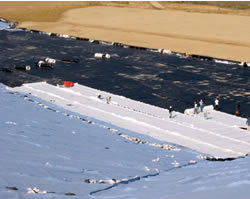Landfill Composite Liner System
Landfills are designed with "cells" that are lined to prevent groundwater contamination. The liner consists of a two-foot layer of low-permeability, re-compacted clay soil. Over this layer, a 60-mil, high-density polyethelene (HDPE) secondary plastic liner is installed to cover the entire bottom and sides of the landfill cell. This plastic liner, which is chemical resistant to corrosion and damage, is then welded together and tested to ensure a continuous seal in accordance with regulatory requirements.

A blanket of geotextile fabric, composed of synthetic, felt-like fibers, is laid above the primary liner system, along with a geonet made of mesh-like plastic. Together, these prevent fine clay particles from clogging the leachate collection layer and promote removal of leachate from the liner surface.
Strict construction guidelines must be followed in constructing the liner system, which are summarized below:
- The qualified liner installation contractor must have certified personnel and equipment to perform the work.
- Personnel performing field liner seaming are qualified by experience and by passing field seaming tests.
- Field seams are oriented parallel to slopes to reduce stress on the seams. Adjacent geomembrane panels will be overlapped to facilitate a strong, double seam. Peel tests are performed on all field seams to ensure strength and seam integrity.
- Final acceptance of the geosynthetic liner system is based on certification by an independent, licensed engineer and quality assurance consultant that certifies the geosynthetic materials have been properly installed
- Following approval of a lined area by a quality assurance inspector, protective cover materials are placed.
- Liner installation/certification reports are submitted to the TCEQ for review and approval.
